- الرئيسية
- معلومات عنا
- صناعة
- الخدمات
- قراءة
- اتصل بنا
سوق الوقود المشتق من الإطارات: التحليل الحالي والتوقعات (2023-2030)
التركيز على النوع (إطارات ممزقة وإطارات كاملة)، والتطبيق (مصانع اللب والورق، وصناعة الإسمنت، وغلايات المرافق، وغيرها)، والتطبيق (توليد الطاقة، والحجز)، والمستخدم النهائي (مركبات الركاب، والمركبات التجارية، وغيرها) والمنطقة/البلد
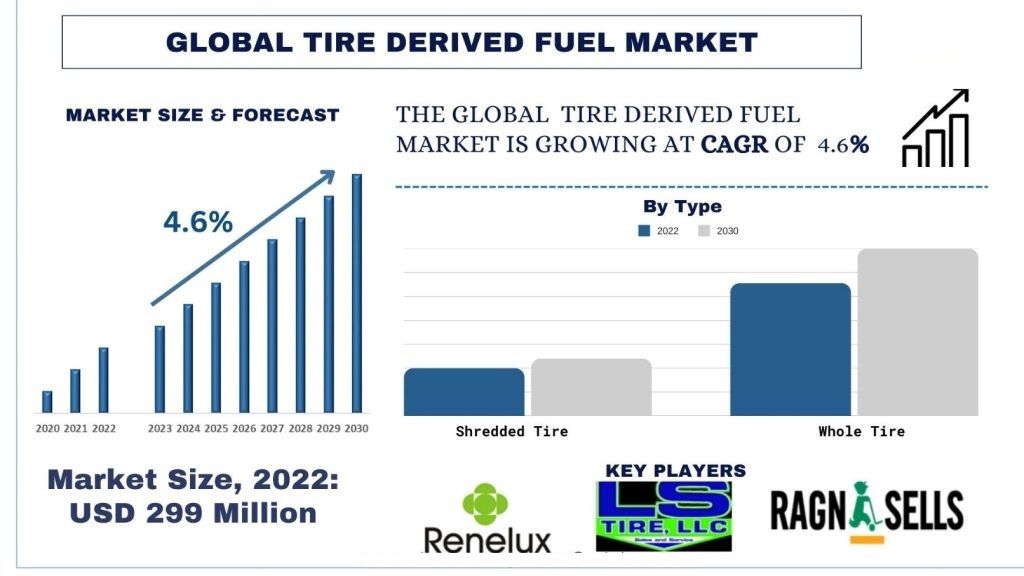
حجم سوق وقود الإطارات المشتقة والتوقعات
بلغت قيمة سوق وقود الإطارات المشتقة 299.39 مليون دولار أمريكي ومن المتوقع أن ينمو بمعدل نمو سنوي مركب قوي يبلغ حوالي 4.6٪ خلال الفترة المتوقعة (2023-2030) بسبب ارتفاع معدل انتشار فقدان الأطراف.
تحليل سوق وقود الإطارات المشتقة
هذا النمو مدفوع بارتفاع عدد المركبات على الطريق على مستوى العالم، وكذلك توليد إطارات الخردة. يوفر TDF طريقة لاستخدام هذا المنتج النفايات. يوفر TDF قيمة حرارية أعلى من الفحم أو الخشب، مما يجعله مصدر وقود بديل جذابًا للصناعات مثل صناعة الأسمنت وتوليد الطاقة. بالمقارنة مع الفحم، يمكن أن يؤدي TDF إلى انخفاض انبعاثات أكاسيد الكبريت مما سيساعد في تغير المناخ والحد من تلوث الهواء على مستوى العالم.
هناك أيضًا بعض التحديات التي تواجه سوق TDF:
اللوائح الصارمة: يمكن أن يؤدي حرق الإطارات إلى إطلاق انبعاثات ضارة إذا لم يتم ذلك بشكل صحيح. يمكن أن تجعل اللوائح المتعلقة بالتحكم في الانبعاثات من الصعب على بعض المرافق استخدام TDF.
التصور العام: هناك مخاوف بشأن التأثير البيئي لحرق الإطارات، مما قد يعيق التبني على نطاق أوسع.
بشكل عام، يتمتع سوق وقود الإطارات المشتقة بإمكانات للنمو، مدفوعة بمشكلة إطارات النفايات المتزايدة والقيمة الحرارية العالية للوقود. ومع ذلك، تظل اللوائح الأكثر صرامة والتصور العام من التحديات.
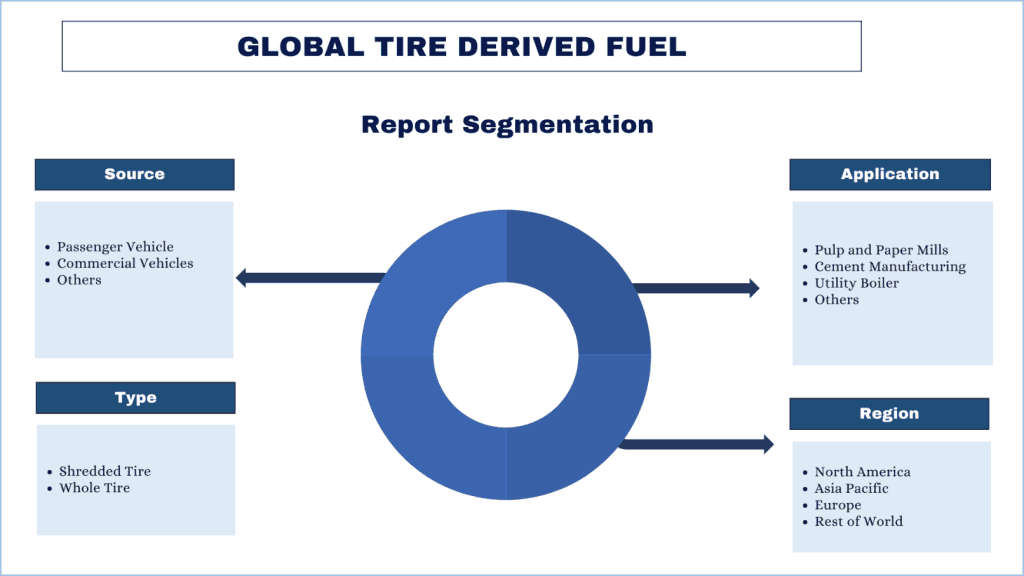
اتجاهات سوق وقود الإطارات المشتقة
يناقش هذا القسم اتجاهات السوق الرئيسية التي تؤثر على مختلف قطاعات سوق وقود الإطارات المشتقة كما حددها فريق خبراء الأبحاث لدينا.
زيادة التركيز على الاستدامة هو اتجاه رئيسي يقود نمو سوق وقود الإطارات المشتقة (TDF).
على الصعيد العالمي، يتم توليد كمية هائلة من إطارات الخردة. تشكل هذه الإطارات مخاطر بيئية عندما يتم تخزينها في مدافن النفايات وتشغل مساحة قيمة. يوفر TDF حلاً مستدامًا عن طريق تحويل هذه النفايات إلى مصدر وقود قابل للاستخدام. تعمل اللوائح الأكثر صرامة والتركيز المتزايد على إدارة النفايات المسؤولة على تحفيز إيجاد بدائل لمدافن النفايات للإطارات المستعملة. يقوم TDF بتحويل الإطارات من مدافن النفايات، مما يقلل من تأثيرها البيئي. علاوة على ذلك، يعزز TDF الاقتصاد الدائري عن طريق إبقاء إطارات النفايات قيد الاستخدام. بدلاً من أن ينتهي بهم المطاف في مدافن النفايات، يتم إعادتهم إلى الدورة الاقتصادية كمصدر وقود قيم. يعتبر الاعتماد على الوقود الأحفوري مساهماً رئيسياً في تغير المناخ. يوفر TDF خيار وقود بديل أكثر صداقة للبيئة.
كيف تغذي الاستدامة نمو السوق:
مع تزايد التركيز على الاستدامة، تتسبب اللوائح وضغط المستهلكين في استكشاف الصناعات لمصادر الوقود البديلة. يظهر TDF كخيار قابل للتطبيق يتماشى مع الممارسات المستدامة. يمكن للشركات التي تتبنى TDF أن تقلل من بصمتها البيئية وتعزز صورة علامتها التجارية، مما يمنحها ميزة تنافسية. علاوة على ذلك، يمكن أن تؤدي زيادة الوعي العام بالفوائد البيئية لـ TDF إلى زيادة قبول السوق والطلب على TDF من الصناعات.
من المرجح أن تظل الاستدامة قوة مهيمنة تشكل سوق وقود الإطارات المشتقة. مع استمرار تزايد المخاوف البيئية، ستكون قدرة TDF على معالجة تحديات إدارة النفايات وتقديم مصدر وقود أكثر استدامة محركًا مهمًا للنمو.
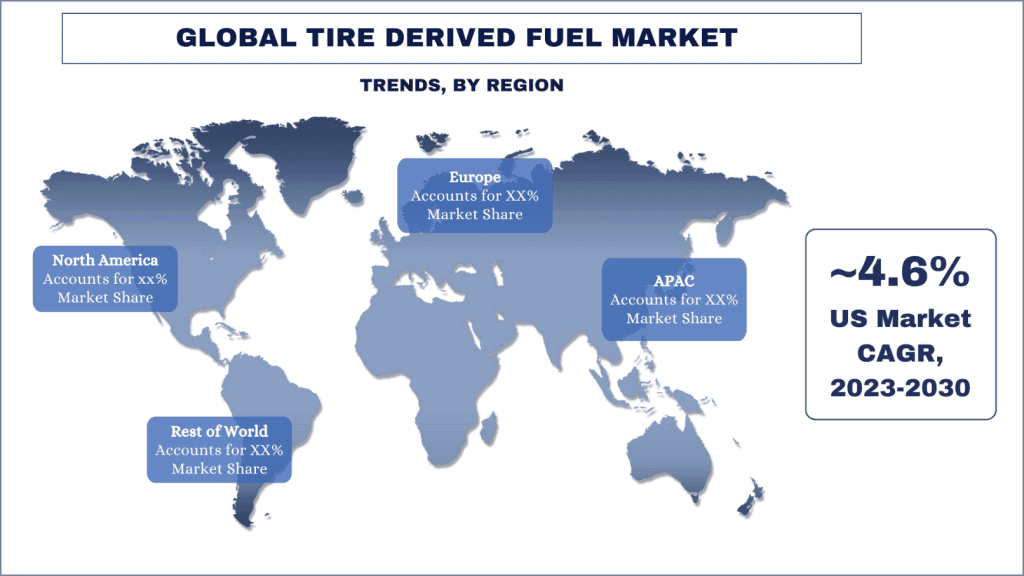
من المتوقع أن تنمو منطقة آسيا والمحيط الهادئ بمعدل نمو سنوي مركب كبير خلال الفترة المتوقعة.
تشهد منطقة آسيا والمحيط الهادئ بالفعل نموًا كبيرًا في سوق وقود الإطارات المشتقة (TDF) بسبب دول مثل الصين والهند، التي تشهد نموًا في إنتاج وبيع السيارات. بسبب الزيادة في مبيعات المركبات، هناك زيادة هائلة في إطارات الخردة المتولدة كل عام، مما يخلق مادة وسيطة متاحة بسهولة لسوق TDF. تقوم الحكومات في العديد من دول آسيا والمحيط الهادئ بتنفيذ لوائح وسياسات بيئية أكثر صرامة تشجع ممارسات إدارة النفايات المستدامة والتي تشمل الترويج لاستخدام الوقود البديل مثل TDF لتقليل الاعتماد على مدافن النفايات والوقود الأحفوري التقليدي. علاوة على ذلك، تبحث الاقتصادات النامية في منطقة آسيا والمحيط الهادئ عن بدائل اقتصادية. يقدم TDF بديلاً تنافسيًا من حيث التكلفة للوقود التقليدي مثل الفحم، وخيارًا جذابًا للصناعات التي تسعى إلى تحسين ميزانيات الوقود الخاصة بها. تشهد منطقة آسيا والمحيط الهادئ تطورات في تقنيات معالجة TDF. يتيح ذلك إنتاج TDF أكثر كفاءة ونظافة، مما يجعله خيارًا أكثر مسؤولية بيئيًا للصناعات.
نظرة عامة على صناعة وقود الإطارات المشتقة
سوق وقود الإطارات المشتقة تنافسي ومجزأ، مع وجود العديد من اللاعبين في السوق العالميين والدوليين. يتبنى اللاعبون الرئيسيون استراتيجيات نمو مختلفة لتعزيز وجودهم في السوق، مثل الشراكات والاتفاقيات والتعاون وإطلاق المنتجات الجديدة والتوسعات الجغرافية وعمليات الاندماج والاستحواذ. بعض اللاعبين الرئيسيين العاملين في السوق هم Renelux Cyprus، LS Tire LLC.، Tire Disposal & Recycling.، Ragn-Sells Group، Reliable Tire Disposal، Scandinavian Enviro System، Liberty Tire Recycling، Lakin Tire West، GLOBAL TIRE RECYCLING OF SUMTER CO، وResourceCo.
أخبار سوق وقود الإطارات المشتقة
- 2022: Neste، وهي شركة وقود متجدد، تعلن عن شراكة مع شركة فنلندية لإدارة النفايات لاستكشاف المعالجة المشتركة لـ TDF مع النفايات البلاستيكية.
- تمنح وزارة الطاقة الأمريكية منحًا للعديد من المشاريع البحثية التي تركز على تطوير تقنيات معالجة TDF المتقدمة.
- 2023: مشروع مشترك بين شركتين يابانيتين يؤسس منشأة جديدة تستخدم الانحلال الحراري بمساعدة الميكروويف لإعادة تدوير الإطارات.
- يقدم الاتحاد الأوروبي لوائح أكثر صرامة بشأن التخلص من إطارات النفايات، مما يزيد من تحفيز استخدام TDF كبديل مستدام.
تغطية تقرير سوق وقود الإطارات المشتقة
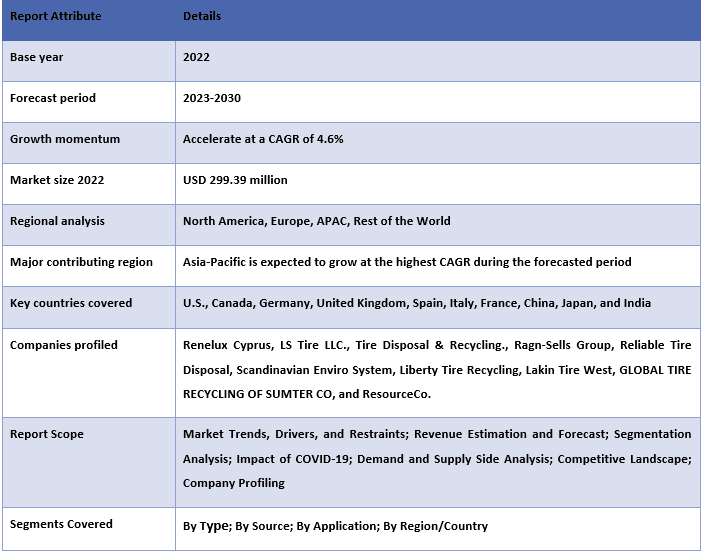
أسباب شراء هذا التقرير:
- تتضمن الدراسة تحليل تقدير حجم السوق والتنبؤ به والذي تم التحقق من صحته من قبل خبراء الصناعة الرئيسيين الموثوق بهم.
- يقدم التقرير مراجعة سريعة للأداء العام للصناعة في لمحة.
- يغطي التقرير تحليلاً متعمقًا لنظراء الصناعة البارزين مع التركيز الأساسي على البيانات المالية التجارية الرئيسية، ومحافظ المنتجات، واستراتيجيات التوسع، والتطورات الأخيرة.
- فحص تفصيلي للدوافع والقيود والاتجاهات الرئيسية والفرص السائدة في الصناعة.
- تغطي الدراسة بشكل شامل السوق عبر قطاعات مختلفة.
- تحليل متعمق على المستوى الإقليمي للصناعة.
خيارات التخصيص:
يمكن تخصيص سوق وقود الإطارات المشتقة العالمي بشكل أكبر وفقًا للمتطلبات أو أي قطاع آخر من السوق. إلى جانب ذلك، تتفهم UMI أن لديك احتياجات عمل خاصة بك، لذا لا تتردد في الاتصال بنا للحصول على تقرير يناسب متطلباتك تمامًا.

يمكنك أيضًا شراء أجزاء من هذا التقرير. هل تريد الاطلاع على قسم من الحكمة
قائمة الأسعار؟
جدول المحتويات
منهجية البحث لتحليل سوق الوقود المشتق من الإطارات (2023-2030)
كان تحليل السوق التاريخية، وتقدير السوق الحالية، والتنبؤ بالسوق المستقبلية لسوق الوقود المشتق من الإطارات العالمي هي الخطوات الرئيسية الثلاث التي اتخذت لإنشاء وتحليل اعتماد الوقود المشتق من الإطارات في المناطق الرئيسية على مستوى العالم. تم إجراء بحث ثانوي شامل لجمع أرقام السوق التاريخية وتقدير حجم السوق الحالي. ثانيًا، للتحقق من صحة هذه الرؤى، تم أخذ العديد من النتائج والافتراضات في الاعتبار. علاوة على ذلك، تم إجراء مقابلات أولية شاملة أيضًا، مع خبراء الصناعة عبر سلسلة القيمة لسوق الوقود المشتق من الإطارات العالمي. بعد افتراض أرقام السوق والتحقق من صحتها من خلال المقابلات الأولية، استخدمنا نهجًا من أعلى إلى أسفل / من أسفل إلى أعلى للتنبؤ بحجم السوق الكامل. بعد ذلك، تم اعتماد طرق تقسيم السوق وتثليث البيانات لتقدير وتحليل حجم سوق القطاعات والقطاعات الفرعية التي تنتمي إليها الصناعة. يتم شرح المنهجية التفصيلية أدناه:
تحليل حجم السوق التاريخي
الخطوة 1: دراسة متعمقة للمصادر الثانوية:
تم إجراء دراسة ثانوية تفصيلية للحصول على حجم السوق التاريخي لسوق الوقود المشتق من الإطارات من خلال مصادر الشركة الداخلية مثل التقارير السنوية والبيانات المالية، وعروض الأداء، والبيانات الصحفية، وما إلى ذلك، والمصادر الخارجية بما في ذلك المجلات والأخبار والمقالات، والمنشورات الحكومية، ومنشورات المنافسين، وتقارير القطاعات، وقاعدة بيانات الطرف الثالث، والمنشورات الموثوقة الأخرى.
الخطوة 2: تجزئة السوق:
بعد الحصول على حجم السوق التاريخي لسوق الوقود المشتق من الإطارات، أجرينا تحليلًا ثانويًا تفصيليًا لجمع رؤى السوق التاريخية وحصصها لمختلف القطاعات والقطاعات الفرعية للمناطق الرئيسية. يتم تضمين القطاعات الرئيسية في التقرير كنوع ومصدر وتطبيق. تم إجراء المزيد من التحليلات على مستوى الدولة لتقييم الاعتماد العام لنماذج الاختبار في تلك المنطقة.
الخطوة 3: تحليل العوامل:
بعد الحصول على حجم السوق التاريخي لمختلف القطاعات والقطاعات الفرعية، أجرينا تحليلًا تفصيليًا للعوامل لتقدير حجم السوق الحالي لسوق الوقود المشتق من الإطارات. علاوة على ذلك، أجرينا تحليلًا للعوامل باستخدام متغيرات تابعة ومستقلة مثل النوع والمصدر وتطبيق سوق الوقود المشتق من الإطارات. تم إجراء تحليل شامل لسيناريوهات جانب الطلب والعرض مع الأخذ في الاعتبار أهم الشراكات وعمليات الاندماج والاستحواذ والتوسع التجاري وإطلاق المنتجات في قطاع سوق الوقود المشتق من الإطارات في جميع أنحاء العالم.
تقدير حجم السوق الحالي والتنبؤ به
تحديد حجم السوق الحالي: بناءً على رؤى قابلة للتنفيذ من الخطوات الثلاث المذكورة أعلاه، توصلنا إلى حجم السوق الحالي واللاعبين الرئيسيين في سوق الوقود المشتق من الإطارات العالمي والحصص السوقية للقطاعات. تم تحديد جميع حصص النسبة المئوية المطلوبة وتقسيمات السوق باستخدام النهج الثانوي المذكور أعلاه وتم التحقق منها من خلال المقابلات الأولية.
التقدير والتنبؤ: لتقدير السوق والتنبؤ بها، تم تخصيص أوزان لعوامل مختلفة بما في ذلك المحركات والاتجاهات والقيود والفرص المتاحة لأصحاب المصلحة. بعد تحليل هذه العوامل، تم تطبيق تقنيات التنبؤ ذات الصلة، أي النهج من أعلى إلى أسفل / من أسفل إلى أعلى، للتوصل إلى توقعات السوق لعام 2030 لمختلف القطاعات والقطاعات الفرعية عبر الأسواق الرئيسية على مستوى العالم. تتضمن منهجية البحث المعتمدة لتقدير حجم السوق:
- حجم سوق الصناعة، من حيث الإيرادات (بالدولار الأمريكي) ومعدل اعتماد سوق الوقود المشتق من الإطارات عبر الأسواق الرئيسية محليًا
- جميع الحصص المئوية والانقسامات والتقسيمات الفرعية لقطاعات السوق والقطاعات الفرعية
- اللاعبون الرئيسيون في سوق الوقود المشتق من الإطارات العالمي من حيث المنتجات المعروضة. أيضًا، استراتيجيات النمو التي يتبناها هؤلاء اللاعبون للتنافس في السوق سريع النمو.
التحقق من صحة حجم السوق وحصته
البحث الأولي: تم إجراء مقابلات متعمقة مع قادة الرأي الرئيسيين (KOLs) بما في ذلك كبار المديرين التنفيذيين (CXO / VPs، رئيس المبيعات، رئيس التسويق، الرئيس التنفيذي للعمليات، الرئيس الإقليمي، الرئيس القطري، إلخ) عبر المناطق الرئيسية. ثم تم تلخيص نتائج البحث الأولي وإجراء تحليل إحصائي لإثبات الفرضية المذكورة. تم دمج المدخلات من البحث الأولي مع النتائج الثانوية، وبالتالي تحويل المعلومات إلى رؤى قابلة للتنفيذ.
تقسيم المشاركين الرئيسيين في المناطق المختلفة
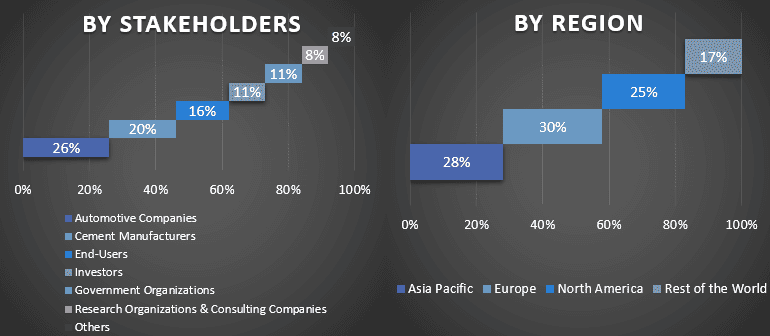
هندسة السوق
تم استخدام تقنية تثليث البيانات لإكمال تقدير السوق الإجمالي والتوصل إلى أرقام إحصائية دقيقة لكل قطاع فرعي من قطاعات سوق الوقود المشتق من الإطارات العالمي. تم تقسيم البيانات إلى عدة قطاعات فرعية بعد دراسة المعلمات والاتجاهات المختلفة في مجالات النوع والتكنولوجيا والمكون والمستخدم النهائي في سوق الوقود المشتق من الإطارات العالمي.
الهدف الرئيسي من دراسة سوق الوقود المشتق من الإطارات العالمي
تم تحديد اتجاهات السوق الحالية والمستقبلية لسوق الوقود المشتق من الإطارات العالمي في الدراسة. يمكن للمستثمرين الحصول على رؤى استراتيجية ليرتكزوا تقديرهم للاستثمارات على التحليل النوعي والكمي الذي تم إجراؤه في الدراسة. حددت اتجاهات السوق الحالية والمستقبلية الجاذبية الكلية للسوق على المستوى الإقليمي، مما يوفر منصة للمشارك الصناعي لاستغلال السوق غير المستغلة للاستفادة من ميزة المحرك الأول. تشمل الأهداف الكمية الأخرى للدراسات ما يلي:
- تحليل حجم السوق الحالي والمتوقع لسوق الوقود المشتق من الإطارات من حيث القيمة (بالدولار الأمريكي). أيضًا، قم بتحليل حجم السوق الحالي والمتوقع لمختلف القطاعات والقطاعات الفرعية.
- تشمل القطاعات في الدراسة مجالات النوع والمصدر والتطبيق.
- تحديد وتحليل الإطار التنظيمي للوقود المشتق من الإطارات
- تحليل سلسلة القيمة التي تنطوي على وجود وسطاء مختلفين، جنبًا إلى جنب مع تحليل سلوكيات العملاء والمنافسين في الصناعة.
- تحليل حجم السوق الحالي والمتوقع لسوق الوقود المشتق من الإطارات للمنطقة الرئيسية.
- تشمل الدول الرئيسية في المناطق التي تمت دراستها في التقرير آسيا والمحيط الهادئ وأوروبا وأمريكا الشمالية وبقية العالم
- ملفات تعريف الشركة لسوق الوقود المشتق من الإطارات واستراتيجيات النمو التي يتبناها اللاعبون في السوق للحفاظ على بقائهم في السوق سريع النمو.
- تحليل متعمق على المستوى الإقليمي للصناعة
الأسئلة الشائعة الأسئلة الشائعة
س1: ما هو حجم السوق الحالي وإمكانات النمو لسوق الوقود المشتق من الإطارات؟
س2: ما هي العوامل الدافعة لنمو سوق الوقود المشتق من الإطارات؟
س3: أي قطاع لديه الحصة الأكبر في سوق الوقود المشتق من الإطارات حسب النوع؟
س 4: ما هي التقنيات والاتجاهات الناشئة في سوق الوقود المشتق من الإطارات؟
س5: أي منطقة ستسيطر على سوق الوقود المشتق من الإطارات؟
ذات صلة التقارير
العملاء الذين اشتروا هذا المنتج اشتروا أيضًا










